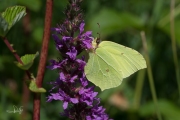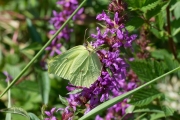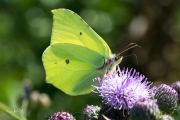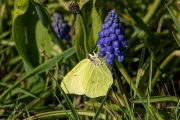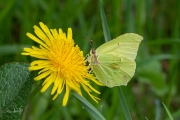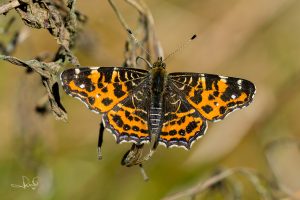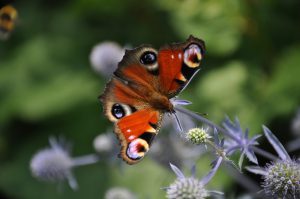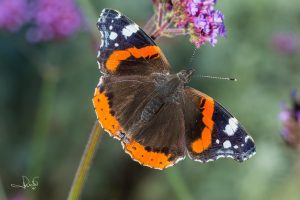There are a few butterfly species that you can see at the very beginning of the year, when the first rays of sun pierce between the clouds and the temperature starts to get slightly more pleasant. I wrote before about the peacock (Aglais io), the comma butterfly (Polygonia c-album) and the small tortoiseshell (Aglais urticae) that show themselves early in the year. These all hibernate as adult butterflies, and so does the brimstone (Gonepteryx rhamni). It is a butterfly that certainly stands out in the field with its fresh yellow colour in early spring.
Good camouflage
As long as the brimstone flutters around, the bright yellow colour of the males contrasts nicely with the environment. The females are rather pale yellow to yellowish white and can easily be confused with butterflies as the small white (Pieris rapae), large white (Pieris brassicae) and the green-veined white (Pieris napi). As soon as the brimstone sits stil it often becomes a bit more difficult to discover it. Especially when it’s sat between the budding light green leaves. The butterfly usually holds its wings closed when resting and because of the greenish colour of the underside of the wing, they hardly stand out. The camouflage is further enhanced by the brown spots on the wings and also by the strongly delineated veins on its wings that resemble leaf veins and the pointed tips of the fore and hind wings.
Old butterflies
You can see brimstones from March to October with two clear peaks around May and August. As I wrote before,the brimstone is a species that overwinters as an adult. They spend the winter in a sheltered spot in dense vegetation, for example in evergreen plants such as holly (Ilex aquifolium) and common ivy (Hedera helix). But also in tussocks of grasses and rushes. So if it’s not too cold and the sun shines through, you may see the first brimstone of the year that is probably looking for another place to sleep. However, when spring really arrives, the males go in search of females, chasing everything that is light in colour and flutters. So the first peak of brimstones in springtime comes from the hibernating specimens. Incidentally, these hibernators may well contain butterflies from the previous spring, because it is known that brimstones can live up to a year. And that makes it one of the longest living butterfly species in the Netherlands.
Sleepyhead
After the males found a female to mate, she deposits her eggs exclusively on common buckthorn (Rhamnus cathartica) and alder buckthorn (Frangula alnus). Then her work is done, the female brimstones can only mate once. After the eggs hatch, the small caterpillars feast on the leaves of the host plant and after three to five weeks of feeding the caterpillars pupate. The pupal stage does not last that long and the butterfly already emerges after about seven to ten days. These young butterflies go into a kind of summer hibernation. In July they start flying around again and this causes the second peak of brimstones. It seems a bit aimless, because mating only takes place in the spring. Around autumn they go back to hibernate and the cycle starts again in the spring. They therefore spend most of their butterfly life in rest. Real sleepyheads, those brimstones.
Sulphur
The brimstone owes its species name rhamni to the host plants of the genus Rhamnus. The genus name Gonepteryx comes from the angular points on the wings: gonia is Greek for angle (compare trigonometry) and pteryx comes from the Ancient Greek pteron meaning wing. In the Netherlands the brimstone is called lemon butterfly because of its colour. The French and Germans also see the link to this citrus fruit, because they call the creature le citron or papillon-citron and Zitronenfalter respectively. The English name has also a connection with the colour of the butterfly, but from a different angle. Brimstone is an alternative name for sulphur. This substance is yellow and there’s the link with the butterfly. There is, by the way, also a bright yellow moth that is called brimstone. Usually followed by ‘moth’ to avoid confusion with the butterfly. This brimstone moth (Opisthograptis luteolata) is a nocturnal moth, so you can’t confuse both specimen.
Fussy
The brimstone is a common species in the Netherlands but there is still a slight chance that you will not find it in your area. They are picky in terms of host plant, because only the two species mentioned above are eligible. Alder buckthorn is mainly found on wet to moist, acidic soil in deciduous forests. Sometimes also on fairly dry open sandy soil, such as in the dunes. This shrub does not occur naturally on clay. Common buckthorn has a preference for moist calcareous or loamy soil in deciduous forests, so you will not find that everywhere in the Netherlands in nature. However, both species are also often planted in forest stands and parks, but also in gardens and seem to thrive there quite nicely. So if you want brimstones in your garden or surroundings, plant some buckthorns. By doing this you also increase the chance of a holly blue (Celastrina argiolus), because this butterfly also uses the buckthorns as a host plant.
Sources:
This blog was originally published in Dutch on April 14th 2021



